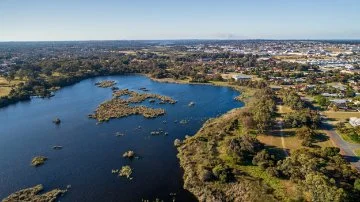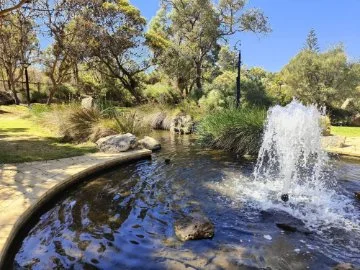The City of Joondalup is home to both artificial and natural wetlands, with the conservation-significant wetlands of Yellagonga Regional Park serving as an example of the natural wetlands. Historically, wetlands covered extensive areas across the Perth metropolitan region, but many have been filled in over time to accommodate urban development.
Wetlands provide a home to a vast array of plants and animals, help to filter and clean water, and prevent flooding. The few wetlands that remain face increasing threats and can become degraded, so it is important that they are looked after and protected.
Yellagonga Regional Park
The most significant wetlands within the City are within the Yellagonga Regional Park, a 13km long chain of interconnected natural wetlands. Yellagonga Regional Park is one of seven Regional Parks within the Swan Coastal Plain.
The Yellagonga wetlands include four waterbodies: Lake Joondalup in the north and Lake Goollelal in the south, which are connected by Beenyup and Walluburnup Swamps. The four wetlands of the Yellagonga Regional Park are all connected with surface water flowing north from Lake Goollelal to Lake Joondalup.
Lake Joondalup is the largest remaining lake in the Perth metropolitan area and the Yellagonga Regional Park wetlands represent some of the last remaining freshwater systems in the Perth metropolitan area.
The Yellagonga Regional Park wetlands provide an important habitat for many plants and animals. They also reduce flood risk, filter and recharge water, and prevent soil erosion.
Natural and artificial wetlands

Natural wetlands
The City is home to several natural wetlands including Lake Yellagonga and Lake Goollelal. These wetlands have been preserved and provide key habitat to our local wildlife. Next time you take a walk around the City’s lakes keep an eye and ear out for how many animals call our natural wetlands home.

Artificial wetlands
The City has many artificial wetlands which have been created or modified natural wetlands to provide habitat connectivity throughout the City. Not only do these wetlands provide aesthetic values to the community but also additional habitat, foraging space, and nesting areas for the City’s waterbirds, amphibians, and turtles.
Caring for our wetlands
Map of wetlands
View the map below to find local natural and artificial wetland areas.
